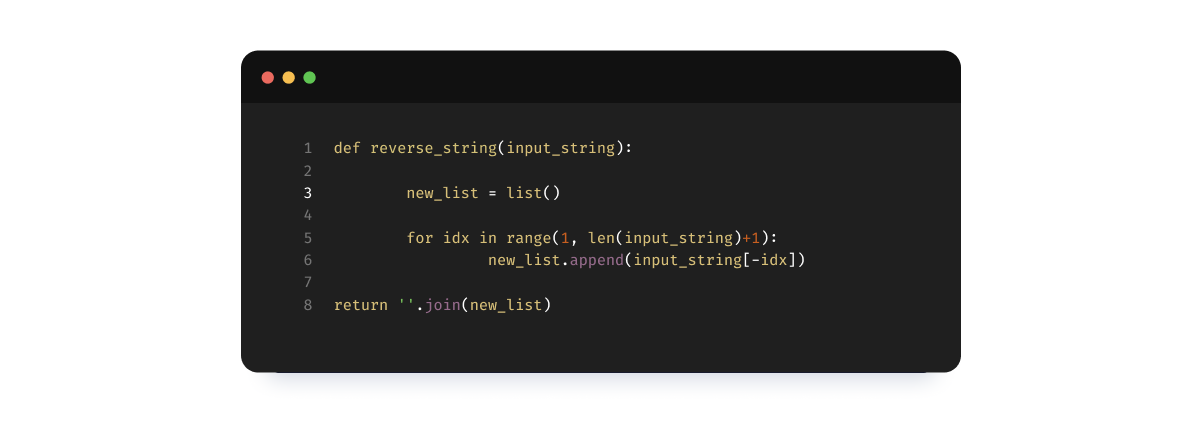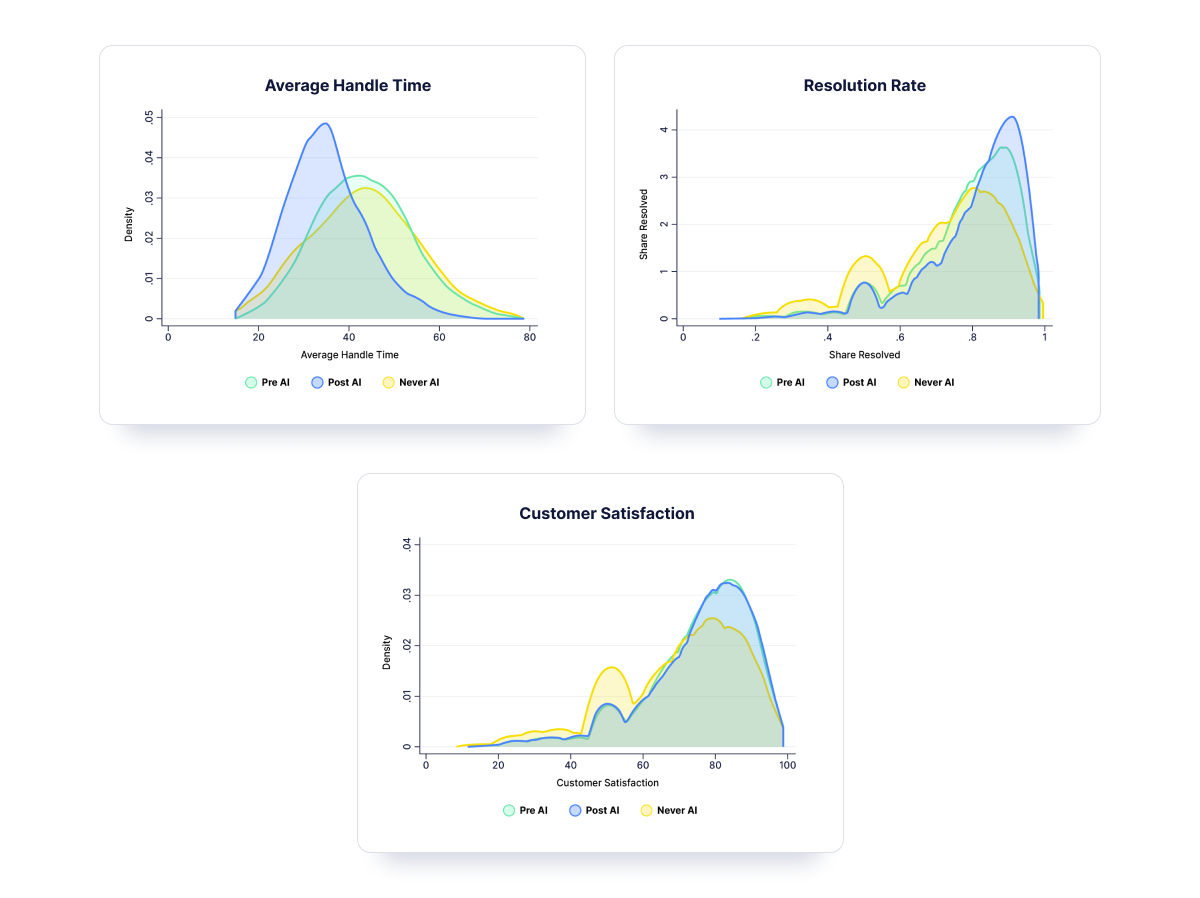If you’re reading this, you’ve probably had a chance to play around with ChatGPT or one of the other large language models (LLMs) that have been making waves and headlines in recent months.
Concerns around automation go back a long way, but there’s long been extra worry about the possibility that machines will make human labor redundant. If you’ve used generative AI to draft blog posts or answer technical questions, it’s natural to wonder if perhaps algorithms will soon be poised to replace humans in places like contact centers.
Given how new these LLMs are there has been little scholarship on how they’ve changed the way contact centers function. But “Generative AI at Work” by Erik Brynjolfsson, Danielle Li, and Lindsey R. Raymond took aim at exactly this question.
The results are remarkable. They found that access to tools like ChatGPT not only led to a marked increase in productivity among the lowest-skilled workers, it also had positive impacts on other organizational metrics, like reducing turnover.
Today, we’re going to break this economic study down, examining its methods, its conclusions, and what they mean for the contact centers of the future.
Let’s dig in!
A Look At “Generative AI At Work”
The paper studies data from the use of a conversational AI assistant by a little over 5,000 agents working in customer support.
It contains several major sections, beginning with a technical primer on what generative AI is and how it works before moving on to a discussion of the study’s methods and results.
What is Generative AI?
Covering the technical fundamentals of generative AI will inform our efforts to understand the ways in which this AI technology affected work in the study, as well as how it is likely to do so in future deployments.
A good way to do this is to first grasp how traditional, rules-based programming works, then contrast this with generative AI.
When you write a computer program, you’re essentially creating a logical structure that furnishes instructions the computer can execute.
To take a simple case, you might try to reverse a string such as “Hello world”. One way to do this explicitly is to write code in a language like Python which essentially says:
“Create a new, empty list, then start at the end of the string we gave you and work forward, successively adding each character you encounter to that list before joining all the characters into a reversed string”:

Despite the fact that these are fairly basic instructions, it’s possible to weave them into software that can steer satellites and run banking infrastructure.
But this approach is not suitable for every kind of problem. If you’re trying to programmatically identify pictures of roses, for example, it’s effectively impossible to do this with rules like the ones we used to reverse the string.
Machine learning, however, doesn’t even try to explicitly define any such rules. It works instead by feeding a model many pictures of roses, and “training” it to learn a function that lets it identify new pictures of roses it has never seen before.
Generative AI is a kind of machine learning in which gargantuan models are trained on mind-boggling amounts of text data until they’re able to produce their own, new text. Generative AI is a distinct sub-branch of ML because its purpose is generation, while other kinds of models might be aimed at tasks like classification and prediction.
Is Generative AI The Same Thing As Large Language Models?
At this point, you might be wondering how whether generative AI is the same thing as LLMs. With all the hype and movement in the space, it’s easy to lose track of the terminology.
LLMs are a subset of the broader category of generative AI. All LLMs are generative AI, but there are generative algorithms that work with images, music, chess moves, and other things besides natural language.
How Did The Researchers Study the Effects of Generative AI on Work?
Now we understand that ML learns to recognize patterns, how this is different from classical computer programming, and how generative AI fits into the whole picture.
We can now get to the meat of the study, beginning with how Brynjolfsson, Li, and Raymond actually studied the use of generative AI by workers at a contact center.
The firm from which they drew their data is a Fortune 500 company that creates enterprise software. Its support agents are located mainly in the Phillippines (with a smaller number in the U.S.) to resolve customer issues via a chat interface.
Most of the agent’s job boils down to answering questions from the owners of small businesses that use the firm’s software. Their productivity is assessed via how long it takes them to resolve a given issue (“average handle time”), the fraction of total issues a given agent is able to resolve to the customer’s satisfaction (“resolution rate”), and the net number of customers who would recommend the agent (“net promoter score.”)

The AI used by the firm is a version of GPT which has received additional training on conversations between customers and agents. It is mostly used for two things: generating appropriate responses to customers in real-time and surfacing links to the firm’s technical documentation to help answer specific questions about the software.
Bear in mind that this generative AI system is meant to help the agents in performing their jobs. It is not intended to – and is not being trained to – completely replace them. They maintain autonomy in deciding whether and how much of the AI’s suggestions to take.
How Did Generative AI Change Work?
Next, we’ll look at what the study actually uncovered.
There were four main findings, touching on how total worker productivity was impacted, whether productivity gains accrued mainly to low-skill or high-skill workers, how access to an AI tool changed learning on the job, and how the organization changed as a result.
1. Access to Generative AI Boosted Worker Productivity
First, being able to use the firm’s AI tool increased worker productivity by almost 14%. This came from three sources: a reduction in how long it took any given agent to resolve a particular issue, an expansion in the total number of resolutions an agent was able to work on in an hour, and a small jump in the fraction of chats that were completed successfully.

This boost happened very quickly, showing up in the first month after deployment, growing a little in the second month, and then remaining at roughly that level for the duration of the study.
2. Access to Generative AI Was Most Helpful for Lower-Skilled Agents
Intriguingly, the greatest productivity gains were seen among agents that were relatively low-skill, such as those that were new to the job, with longer-serving, higher-skilled agents seeing virtually none.
The agents in the very bottom quintile for skill level, in fact, were able to resolve 35% more calls per hour—a substantial jump.

With the benefit of hindsight it’s tempting to see these results as obvious, but they’re not. Earlier studies have usually found that the benefits of new computing technologies accrued to the ablest workers, or led firms to raise the bar on skill requirements for different positions.
If it’s true that generative AI is primarily going to benefit less able employees, this fact alone will distinguish it from prior waves of innovation. [1]
3. Access To Generative AI Helps New Workers “Move Down the Learning Curve”
Perhaps the most philosophically interesting conclusion drawn by the study’s authors relates to how generative AI is able to partially learn the tacit knowledge of more skilled workers.
The term “tacit knowledge” refers to the hard-to-articulate behaviors you pick up as you get good at something.
Imagine trying to teach a person how to ride a bike. It’s easy enough to give broad instructions (“check your shoelaces”, “don’t brake too hard”), but there ends up being a billion little subtleties related to foot placement, posture, etc. that are difficult to get into words.
This is true for everything, and it’s part of what distinguishes masters from novices. It’s also a major reason for the fact that many professions have been resistant to full automation.
Remember our discussion of how rule-based programming is poorly suited to tasks where the rules are hard to state? Well, that applies to tasks involving a lot of tacit knowledge. If no one, not even an expert, can tell you precisely what steps to take to replicate their results, then no one is going to be able to program a computer to do it either.
But ML and generative AI don’t face this restriction. With data sets that are big enough and rich enough, the algorithms might be able to capture some of the tacit knowledge expert contact center agents have, e.g. how they phrase replies to customers.
This is suggested by the study’s results. By analyzing the text of customer-agent interactions, the authors found that novice agents using generative AI were able to sound more like experienced agents, which contributed to their success.
4. Access to Generative AI Changed the Way the Organization Functioned
Organizations are profoundly shaped by their workers, and we should expect to see organization-level changes when a new technology dramatically changes how employees operate.
Two major findings from the study were that employee turnover was markedly reduced and there were far fewer customers “escalating” an issue by asking to speak to a supervisor. This could be because agents using generative AI were overall treated much better by customers (who have been known to become frustrated and irate), leading to less stress.
The Contact Center of the Future
Generative AI has already impacted many domains, and this trend will likely only continue going forward. “Generative AI At Work” provides a fascinating glimpse into the way that this technology changed a large contact center by boosting productivity among the least-skilled agents, helping disseminate the hard-won experience of the most-skilled agents, and overall reducing turnover and dissatisfaction.
If this piece has piqued your curiosity about how you can use advanced AI tools for customer-facing applications, schedule a demo of the Quiq conversational CX platform today.
From resolving customer complaints with chatbots to automated text-message follow-ups, we’ve worked hard to build a best-in-class solution for businesses that want to scale with AI.
Let’s see what we can do for you!
[1] See e.g. this quote: “Our paper is related to a large literature on the impact of various forms of technological adoption on worker productivity and the organization of work (e.g. Rosen, 1981; Autor et al., 1998; Athey and Stern, 2002; Bresnahan et al., 2002; Bartel et al., 2007; Acemoglu et al., 2007; Hoffman et al., 2017; Bloom et al., 2014; Michaels et al., 2014; Garicano and Rossi-Hansberg, 2015; Acemoglu and Restrepo, 2020). Many of these studies, particularly those focused on information technologies, find evidence that IT complements higher-skill workers (Akerman et al., 2015; Taniguchi and Yamada, 2022). Bartel et al. (2007) shows that firms that adopt IT tend to use more skilled labor and increase skill requirements for their workers. Acemoglu and Restrepo (2020) study the diffusion of robots and find that the negative employment effects of robots are most pronounced for workers in blue-collar occupations and those with less than a college education. In contrast, we study a different type of technology—generative AI—and find evidence that it most effectively augments lower-skill workers.”




